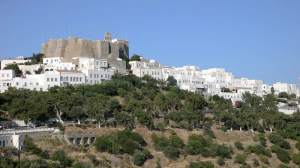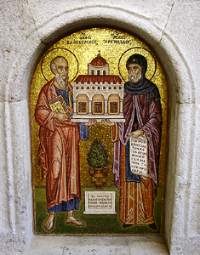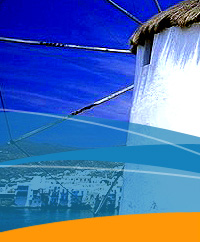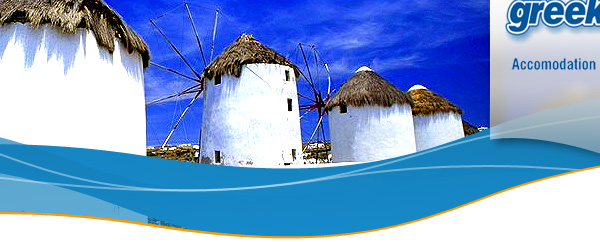 The monastery of Saint John the Theologician began to be built in 1088 by Saint Christodoulos the Latrinos, who had been granted the whole island of Patmos with a golden bull by the Emperor of Byanztium Alexis the First, Komninos. The monastery of Saint John the Theologician began to be built in 1088 by Saint Christodoulos the Latrinos, who had been granted the whole island of Patmos with a golden bull by the Emperor of Byanztium Alexis the First, Komninos.
Hes was named Latrinos, because before he went of Patmos he lived on the mountain of Latrous, but due to the Turks he asked the Emperor to grand him the small, desolate and arid island of Patmos, for him to settle there. Some monks and citizens came to live on the island with Saint Christodoulos, who were mainly from Crete and Asia Minor. The last ones according to the golden bull of Alexis the FIrst, had to be without wives or children Once the Monastery and the fortress were complete, the need for cultivation arose. However, as the Saint realized that it would be impossible to ensure permanent inhabitants without families he decided to agree to the settlement of families. In fact he obliged all folk to live away from the Monastery, in the north edge of the island, where monks would not be allowed to go! The borders of the folk area were from Saint Nicholas Evdilos to the area of Vagia! These people worked and lived in the Monastery five days a week and for the rest of the days they went back to their families. Yet, this solution was also difficult, and in teh 12th centure a.C., the abbot of the Monastery in the summer months, in order to protect it from the pirate attacks, which were beginning during that period. As a result, in the 13th century, the folk asked to live around the Monastery, so as to be able to be protected but also to protect it at dangerous times. The Monastery belongs to the Ecumenical Patriarchy; it is a Patriarchal exarchate with a Patriarchal exarch, its abbot had special benefits. The 15-meter tall walls of it gave the image of a fortress, in the middle of the island and during the pirates' attacks the inhabitants were protected behind them. Above its two and only gates, there was what is called a killer, a type of balcony, from which the inhabitants were able to pour hot oil, to prevent the pirates from entering.
ARCHITECTURE
The Monastery is built in five levels and its original form of a boat, with its head toward the Ikarian Sea changed, due to certain needs arising for additions and reformations. The cells of the monks are built around the Catholic, according to the Byzantine architecture. Other than that, the building is formed in many different levels and has many of the characteristics of the traditional arhcitecture of the island. The current look of the building is the result of needs arising as the time went past, for additions and forming of rooms, as well as the particularities of the rocky ground of the island.  The Monasteruy has ten chapels, four of which are located in its yard, In the Catholic of the Monastery, there is a temple of unique art, created in 1829, by 12 sculptors. The icons and the frescos in the Catholic are of immense beauty and value. The Monasteruy has ten chapels, four of which are located in its yard, In the Catholic of the Monastery, there is a temple of unique art, created in 1829, by 12 sculptors. The icons and the frescos in the Catholic are of immense beauty and value.
MUSEUM - LIBRARY - VESTRY
The creation of the vestry began by Saint Christodoulos. On its entrance there is a copy of the icon of Apocalypse from 1626. A large part of teh Monastery's heirloom is kept in the vestry, such as invaluable icons, amongst which one can find the mosaic icon of St. Nicholas from the 11th century. Moreover, there are textiles and vestments ebroidered with golden threads, donations from wealthy Patmians. Silver and gold utensils, unique creations, with the most well known of all the mitre of the Patriarch Neophytos the sixth, which is decorated with invaluable stones and gold. Another important part of the Monastery is its library. The library is recorded histroy, not only of the Monastery but also of the whole island. Within the documents of the library there is the founding goldern bull, with which Alexis the First, Komninos granted Patmos to Saint Christodoulos in 1088. It is a rich source of information for the life of the Monastery and teh conditions applied by the conquerors each time (e.g. taxes, forms of trade and administration). In the Chapel of Saint Christodoulos, next to the Catholic, there are the relics of the Saint in a special show area. Moreover, the saint's skull of Apostle Thomas, the relics of St. Steven, St Jacob of Persos, pricelss dialogue manuscript, that was salvaged and kept in teh Holy Monastery of Patmos, was stolen around the 1800s and is currently held at the University of Oxford. It is part of the Clark collection, code no. 39. |




